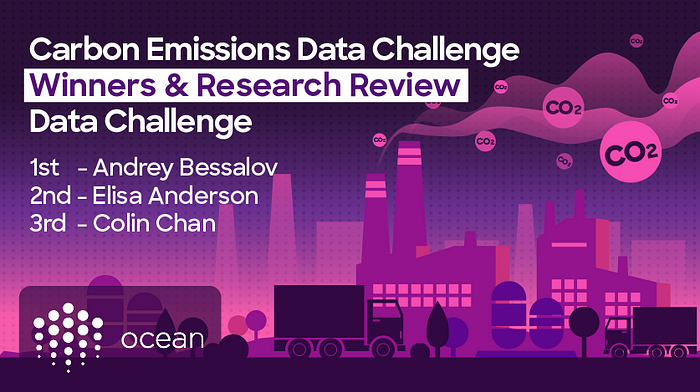‘Forecast Carbon Emission Across Continents’ — Research & Data Challenge Review

Warm or cold, good or bad, global climate constantly changes in various ways. This data challenge used carbon emission rates sorted by each country to prove or debunk common climate change assumptions with data science. Understanding trends of the past and simulating future outcomes through available data seeks to lead to better awareness, business intelligence, and policy shaping in years to come.
Introduction
This Data Challenge ran from November 23 to December 12, 2023, and was the last challenge of the 2023 championship season. The purpose of was challenge was to dissect carbon emission statistics and rates by each country, and then develop predictive models for future emission rates on a continental scale.
The Carbon Emissions data challenge gave a stepping stone to understanding emission rates for intensive purposes of the data challenge experiment. Later R&D on this subject routes to dynamic analytics, data-informed decision-making, and stride to mitigate asymmetric facts and truth about climate change.
To execute, the Ocean Protocol Data Science team and the challenge participants used the provided data made available by the European Commission EDGAR — Emissions Database for Global Atmospheric Research. Two Data Sets were used to weigh carbon emission rates under two different metrics: Co2 (Carbon Dioxide) and GHG (Green House Gases). Each data set weighed its metric at the country level, sector-specific data, per GDP, and Per Capita emission rates.
The key objectives of this data science competition were to analyze the influence of different industry sectors and countries, exercise statistical and machine learning models to derive assumptions, and forecast what the short-term future may look like.
Winners
Participants were tasked with analyzing trends and patterns in the historical data and identifying key drivers of emissions per country per industry sector, per capita, and per GDP. Then, apply these findings to indicators by continent. Beyond the data set provided, participants were encouraged to assess the impact of different sectors and economic activities on emission levels. 13 reports were entered, and 3 have earned podium finishes for USDC prizes and points accrued to their standing in the Ocean Protocol Data Challenge Championship & Leaderboard.
Podium finishers are as follows:
1st — Andrey Bessalov — $2500 USDC
This report is available on the Ocean Market for Consumption here.
Andrey’s report was the best prepared and thorough. The key conclusion was that Asia is the most polluting continent, with recent emission levels reaching approximately 33 Gt GHG and 25 Gt CO2 per year, constituting about two-thirds of the total global emissions. Conversely, Australia is identified as the least polluting continent. This highlights a significant disparity in emission levels across continents, underscoring the crucial role of regional factors in global emission trends.
2nd — Elisa Anderson — $1500 USDC
A key standout in the proposal made by Elisa was the development and application of a sophisticated predictive model. This model, based on Long Short-Term Memory (LSTM) neural network architecture, is designed to forecast CO2 and GHG emissions by continent. The model demonstrates varying levels of predictive accuracy across different regions, highlighting the unique factors influencing emissions in each area.
3rd — Colin Chan — $1000 USDC
This report is available on the Ocean Market for Consumption here
The most interesting takeaway from Colin Chan’s report, “Forecasting Carbon Emissions Across Continents,” is the discovery that Africa has experienced the greatest surge in CO2 emissions, nearly tripling over the observed time period (30 Years). This sharp increase is attributed to the continent’s industrialization and rising demand for transportation services, driven by urbanization and population growth. Conversely, Europe has shown a decrease in CO2 emissions, thanks to investments in renewable energy, strict environmental regulations, and the implementation of the European Union Emissions Trading System. This contrast illustrates the diverse paths of development and environmental impact across different regions.
Results
Global warming is the long-term increase in the Earth’s average surface temperature. Since the pre-industrial period (1850–1900), the Earth’s average surface temperature has increased by about 1 degree Celsius (1.8 degrees Fahrenheit). The Intergovernmental Panel on Climate Change (IPCC) has concluded that it is extremely likely that human activity is the main cause of the observed warming since the mid-20th century. One noteworthy insight derived from this challenge found in this data challenge, that goes against common perception, is that CO2 emissions in Europe have been only declining for the last 30 years, whilst CO2 emissions in Asia for the last 30 years have steadily increased.
Through this exercise, we were able to assume a few key metrics that influence carbon emission rates via Co2 and GHG and define these assumptions before further reading:
The main source of carbon emissions and increased rates globally is burning fossil fuels, such as coal, oil, and natural gas. Fossil fuels are used to generate electricity, power cars and trucks, and heat homes and businesses. Other sources of carbon emissions include deforestation, waste management, alternative energy production, industrial processes, urbanization & population growth, and agriculture.
Global warming is already having several negative effects on the planet.
These effects are expected to become more severe in the future. Some of the most serious effects of global warming include rising sea levels, more extreme weather events, changes in animal and plant life, and soil health & erosion. Here we use data science to diagnose the issues and propose better practices to treat our planet better than the last 30 years.
Exploratory Data Analysis (EDA)
In Asia, the surge in CO2 and GHG emissions is closely linked to rapid population growth, industrialization, and the rise of emerging economies. This region’s dynamic economic development, often driven by energy-intensive industries and expanding urban centers, has significantly increased its carbon footprint.
Meanwhile, continents like Oceania, Europe, and North America have witnessed a decline in emissions, largely attributable to effective environmental policies and a shift towards cleaner energy sources. This contrast highlights the varying trajectories of different regions in addressing climate change, underscoring the need for tailored solutions that consider economic and social contexts.
The same phenomenon is reflected in GHG emissions with Europe improving in its environmental efforts while the rest of the world continues to increase its emissions as Africa
leads the rise. Europe contributed 26.44% of total GHG emissions in 2022, down from 37.40% in 1970. On the other hand, Africa’s contribution rose from 12.70% in 1970 to 20.65%. This dichotomy is largely reflected and expected based on the aforementioned analysis of CO2 emissions.
Co2 vs GHG correlation
The heatmap indicates a strong positive correlation between CO2 emissions and overall greenhouse gas (GHG) emissions, with a correlation coefficient of 0.99.
This suggests that in the dataset analyzed, as CO2 emissions increase or decrease, GHG emissions tend to follow very closely. Given that CO2 is a major component of GHG emissions, this high correlation is expected.
Industry Sector Contribution Correlation
The graphs below show the absolute values of sectoral CO2 and GHG emissions expressed in Mt CO2/yr on the left, and the shares of these values from the total contribution on the right.
The most polluting sector is the Power Industry (generating energy). In recent years, the value of CO2 emissions has reached 30 Gt per year, which is approximately 30% of total GHG emissions, and 40% of total CO2 emissions. The least polluting sector in terms of GHG emissions is Waste.
- The agriculture sector is a significant contributor globally, necessitating sustainable farming practices.
- The building and fuel exploitation sectors call for energy-efficient construction and cleaner energy sources.
- Industrial combustion and the power industry sectors require enhanced regulations and adoption of cleaner technologies.
- Increased waste sector demands improved waste management sustainability globally.
- The transportation sector emphasizes the urgency of sustainable mobility solutions.
Following Per Capita and Per GDP metrics, it was recognized that global average CO2 emissions per capita decreasing from 1990 to 2022 indicates a positive trend towards lower individual carbon footprints. Because GDP and Per Capita benchmarks are continuously increasing, further reasoning for a decrease in correlation could mean several things: Improved energy efficiency, introduction of renewable energy, increased awareness, and policy measures.
Temporal Analysis
In Temporal analysis, research was tasked with Examining the temporal trends in CO2 and GHG emissions across continents. Then, scoring was made on the ability to identify notable patterns or shifts over time, pinpointing periods marked by significant increases or decreases in emissions. Explain these trends, considering policy changes, economic shifts, technological advancements, or natural events that might have influenced the observed patterns. The summary to solve this question is briefed based on averages of the submitted reports.
Over time, all continents recorded a rise in CO2 emissions except for Europe. In the meanwhile, Africa led the pack with the greatest surge in CO2 emissions, nearly tripling throughout the time. This can be possibly explained by the industrialization of Africa as the amount of CO2 emissions from transport rose dramatically in the continent. These include railways, buses, and ferries as the countries experience urbanization and population growth, increasing the demand for transportation services. These signs of economic development often go in tandem with trade and business activities, necessitating transportation services to move goods and people. Furthermore, as Africa’s GDP gradually increases, this enhances the affordability of citizens in the region to purchase vehicles, leading to elevated emissions.
However, with the lack of government policies and public awareness, it fails to sufficiently curb these emission activities and promote sustainable emissions.
As for sectoral composition, agriculture led the greatest fall (23.10% to 19.59%) in contributions to total GHG emissions while Processes contributed the largest rise (10.94% to 14.64%).
Livestock, especially cattle, contribute significantly to methane emissions. The implementation of improved livestock management practices, such as dietary changes and methane capture technologies could contribute to lower emissions from the agriculture sector. As for processes, this could be plausibly explained by the changes in consumer demand and trade patterns which shifted to more energy-intensive manufacturing techniques such as computer parts and electronic equipment, due to the rise in income per capita.
Prediction Model
For predictions, two different approaches were exercised by challenge participants. Drawn between 1) Time Series Analysis, by analyzing historical trends and patterns in the data, time series models like ARIMA and ARIMAX can be employed to predict future emission levels. And 2) Machine Learning by the vehicle of algorithms such as Support Vector Machines, Random Forests, and Neural Networks was trained on the provided data to learn complex relationships and patterns.
For one example, this linear regression model is described here to forecast future global CO2 and GHG emission rates based solely on historical emissions data. The model utilizes the Ordinary Least Squares (OLS) method from the Statsmodels library in Python. The dataset used for training and prediction consists of two columns: ‘Year’ and ‘Emission’, where ‘Year’ represents the respective year, and ‘Emission’ denotes the total CO2 or GHG emissions for that year. The objective was to develop a predictive model that can estimate future total global CO2 emissions based on historical data.
Understanding Emission Rates, Climate Change, & What to Do About It
The “Forecasting Carbon Emissions Across Continents” challenge has been a pivotal journey in understanding the complex dynamics of CO2 and GHG emissions globally. Through meticulous data analysis and advanced modeling, we’ve uncovered distinct emission trends across continents and the substantial impact of various sectors on these emissions. Our models have forecasted emissions for the upcoming three years, providing a crucial tool for policymakers and Environmentalists.
The analysis paints a world where geography and economy intertwine with emissions. While Asia grapples with the environmental costs of rapid growth, the West shows the feasibility of stabilizing emissions. Africa’s trajectory points towards a need for sustainable development models. The insights call for a global response, balancing economic needs with environmental sustainability.
This was the last data challenge of 2023. The 2024 Data Challenge championship is starting soon! Reach out to us in our discord #data-science-hub channel: https://discord.gg/yFRPH9PCN4 for updates and new challenges.
To see past, current, and future data challenges sponsored by Ocean, please visit https://oceanprotocol.com/earn/data-challenges.
About Ocean Protocol
Ocean was founded to level the playing field for AI and data. Ocean tools enable people to privately & securely publish, exchange, and consume data.
Follow Ocean on Twitter or Telegram to keep up to date. Chat directly with the Ocean community on Discord. Or, track Ocean progress now on GitHub.

